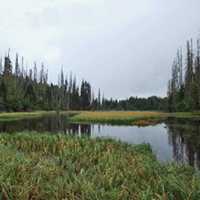Complex effects of acidification, habitat properties and fish stock on littoral macroinvertebrate assemblages in montane standing waters

All claims expressed in this article are solely those of the authors and do not necessarily represent those of their affiliated organizations, or those of the publisher, the editors and the reviewers. Any product that may be evaluated in this article or claim that may be made by its manufacturer is not guaranteed or endorsed by the publisher.
Authors
Littoral macroinvertebrates in acidified waterbodies are affected by the interaction of acidification and local environmental conditions. Understanding the interplay of these factors in the structuring of communities is essential for interpreting responses to and/or recovery from acidification. Here, we analyse the species composition and richness of littoral macroinvertebrates in a range of acidified montane standing waters in relation to water chemistry, littoral characteristics and fish stock. The main species composition gradients were related to pH and conductivity; however, considerable variation along these gradients was associated with local habitat characteristics (changing water levels and littoral structure) and concentration of ionic aluminium and dissolved organic carbon. Although fish stock effects were confounded by correlated acidity, we observed a significant decline in abundance of macroinvertebrates vulnerable to fish predation at sites with fish stock. Overall, littoral macroinvertebrates of acidic waterbodies were diverse due to the heterogeneity of local habitat properties, despite they were dominated by acid-tolerant species. Acidic humic sites with dense, heterogeneous littoral vegetation were species-rich, hosting numerous habitat specialists and rare species, while chronically acidified lakes with high aluminium concentrations and sparse littoral vegetation had species-poor assemblages, characteristic of strong acid-stress. Water level manipulation resulted in serious assemblage impoverishment, overriding the effects of more favourable water chemistry. This study shows that the littoral fauna of acidic waterbodies is structured by complex effects induced by local factors in addition to acidity, resulting in acid-stressed assemblages with relatively high variability, emphasising a need to analyse local habitat factors when evaluating the impact of acidification on macroinvertebrates.
Edited by
Valeria Lencioni, Head Invertebrate Zoology and Hydrobiology Dept., MUSE-Museo delle Scienze, Trento, ItalyHow to Cite

This work is licensed under a Creative Commons Attribution-NonCommercial 4.0 International License.






